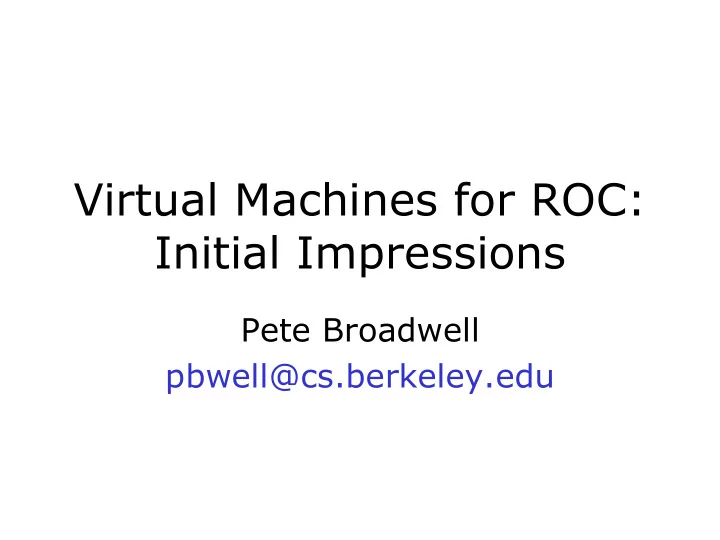

Virtual Machines for ROC: Initial Impressions Pete Broadwell pbwell@cs.berkeley.edu
Talk Outline 1. Virtual Machines & ROC: Common Paths 2. Quick Review of VMware Terminology 3. Case Study: Using VMware for Fault Insertion 4. Future Directions
Background • Virtual machine: an efficient, isolated duplicate of a real machine – Popek & Goldberg • VMware: an x86-based virtual machine environment – Runs on PCs, workstations, servers – Supports Linux and Windows – Began as a research project at Stanford
ROC & Virtual Machines: A Perfect Match?
Recovery-Oriented Features of VMs • VM “sandboxing” • Support for provides effective checkpointing, isolation. undo able sessions • Multiple VMs on one • Significant support machine yields for monitoring and redundancy. diagnostics • Suspend/resume • Online verification capability means fast of recovery failover and mechanisms? restartability.
Type I VM: Stand-Alone • Virtual machine monitor runs on Apps Apps bare hardware, supports multiple Guest OS Guest OS virtual machines. VM VM • Examples: VMware ESX Server, IBM z/VM Virtual Machine Monitor PC Hardware
Type II VM: Hosted • VM app uses driver to load VMM at Apps privileged level. VMM uses host OS Guest OS I/O services through VM app. VM VM Apps App • Examples: VMware Workstation, VM VMM Host OS Driver VMware GSX Server, Connectix PC Hardware Virtual PC, Plex86
Hosted VM I/O Virtualization Apps Guest OS VM Apps VM app Virt Virt Host OS IDE NIC vmnet vmmon Virtual Disk virt bridge VMM Host OS device drivers PC hardware
Case Study: Opportunities for Online Fault Injection in VMware GSX Server
Why VMs for Fault Injection? Fault injection is old news! • ROC goals for fault injection: – Integrated with operating environment – Capable of injecting multiple types – Low overhead, high configurability – Able to expose latent errors in production systems
Which Faults are Important to Inject? • Consider errors that have been observed on x86 PCs. • Of these errors, – Which can be inserted using the existing capabilities of VMware? – Which require that VMware source code must be modified? – Which can’t be injected at all?
VMware does checking of its own!
Memory/Processor Errors • Want to simulate processor faults, memory ECC errors. • Problem: in VMware, processor ops & memory accesses execute directly on hardware (not simulated). • Need to allow VM to return “machine check” exception to guest OS. Not difficult to guess what will happen: kernel panic or blue screen.
Memory Corruption • VMs use file system as backing for pinned memory pages – point for inserting corruption errors. • VM driver (open source) interposes upon memory requests between VMs & host OS – can insert memory errors here. Easy to do, but not very interesting or realistic.
Disk Fault Injection • By default, a VM’s virtual disk image is a flat file. • Failures: catch read/write calls to the file, return errors indicating bad blocks, device failures to OS. • Transient failures: overwrite random portions of disk image. Should be relatively straightforward.
Network Device Faults • VMware’s virtual network module is open-source. • Modify module, introduce failure code at virtual bridges and hubs – Drop packets – Corrupt packets – Simulate slowdown – Simulate DOS attacks
Virtual Hub: No Faults
Virtual Hub: Injected Faults
Cluster-Level Faults • Use VMware’s built-in remote management interface to hard-suspend nodes in a cluster, remove network bridges. • Verify recovery/failover routines in cluster management software. – Dell Scalable Enterprise Computing – MS Cluster Server – NetWare Cluster Services – Microsoft SQL Server!
(Virtual) Cluster Management Interface
Analysis • Levels of difficulty for different fault injection types: – CPU, cache, & memory (non- corruption) are hard to do. – Memory corruption, disk, NIC, peripherals may be medium. – Network, cluster level is easy.
The Big Picture • Want to develop models for multiple correlated faults & implement them. • Combine fault injection with introspection tools for anomaly detection & root-cause analysis.
Recommend
More recommend